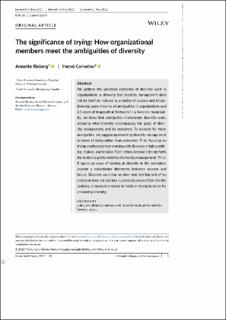| dc.contributor.author | Risberg, Annette | |
| dc.contributor.author | Corvellec, Hervé | |
| dc.date.accessioned | 2022-11-08T13:36:33Z | |
| dc.date.available | 2022-11-08T13:36:33Z | |
| dc.date.created | 2022-08-11T10:58:18Z | |
| dc.date.issued | 2022 | |
| dc.identifier.citation | Gender, Work & Organization. 2022, . | en_US |
| dc.identifier.issn | 0968-6673 | |
| dc.identifier.uri | https://hdl.handle.net/11250/3030684 | |
| dc.description.abstract | We address the uncertain outcomes of diversity work in organizations by showing that diversity management does not let itself be reduced to a matter of success and failure. Drawing upon theories of ambiguities in organizations and 2.5 years of longitudinal fieldwork in a Swedish municipality, we show that ambiguities characterize diversity work, including what diversity encompasses, the goals of diversity management, and its outcomes. To account for these ambiguities, we suggest approaching diversity management in terms of trying rather than outcomes. First, focusing on trying emphasizes that working with diversity entails a shifting, relative, and tension-filled notion. Second, it brings forth the tentative performativity of diversity management. Third, it opens ways of looking at diversity in the workplace beyond a reductionist dichotomy between success and failure. Diversity work has no clear end, but this lack of an endpoint does not call into question its raison d'être. On the contrary, it makes it a reason to insist on trying to strive for enhancing diversity. | en_US |
| dc.language.iso | eng | en_US |
| dc.rights | Attribution-NonCommercial-NoDerivatives 4.0 Internasjonal | * |
| dc.rights.uri | http://creativecommons.org/licenses/by-nc-nd/4.0/deed.no | * |
| dc.subject | ambiguity | en_US |
| dc.subject | diversity management | en_US |
| dc.subject | diversity work | en_US |
| dc.subject | performativity | en_US |
| dc.subject | Sweden | en_US |
| dc.subject | trying | en_US |
| dc.title | The significance of trying: How organizational members meet the ambiguities of diversity | en_US |
| dc.type | Peer reviewed | en_US |
| dc.type | Journal article | en_US |
| dc.description.version | publishedVersion | en_US |
| dc.subject.nsi | VDP::Samfunnsvitenskap: 200 | en_US |
| dc.source.pagenumber | 19 | en_US |
| dc.source.journal | Gender, Work & Organization | en_US |
| dc.identifier.doi | doi.org/10.1111/gwao.12883 | |
| dc.identifier.cristin | 2042364 | |
| cristin.ispublished | true | |
| cristin.fulltext | original | |
| cristin.qualitycode | 2 | |

